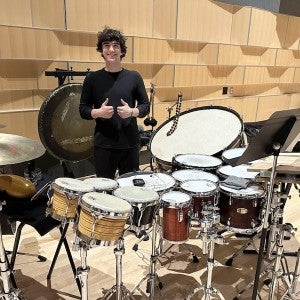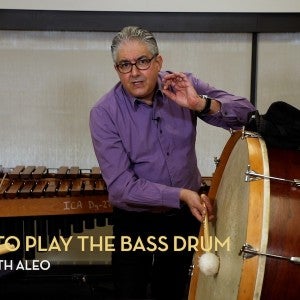How to play the cymbals properly
Learn proper cymbal technique from Interlochen Center for the Arts' Director of Percussion Keith Aleo, including the best gear to use and specific playing technique. Continue your studies by downloading a cymbals étude!
Hi, my name is Keith Aleo and I am the Director of Percussion at the Interlochen Center for the Arts, and I'm here to talk to you about instruments that are often not covered in percussion education. One of those is cymbals, and I say about cymbals that they are the most dangerous instrument in the percussion family. And why do I say they're dangerous? Because a lot can go wrong. They are heavy; they are loud or can be loud; and sometimes they either fall, or they have you try to muffle them and you hurt yourself by muffling them. So hopefully I can talk about a few things to help you have a better experience with cymbals.
Cymbal equipment
The first thing is, what cymbals should you get? What gear? I recommend 18-inch Zildjian cymbals, in the lighter models, medium light, a little easier to play. For middle school program or small hands, maybe you'd go to a 17- or even a 16-inch. You want to have a leather strap, which you can see here, and if you notice I have no pad on my cymbals. Pads are for marching. And if you notice, also, there's no ring around the hole, and that those rings again are for marching, and that ring can buzz often times. Alright, so 18-inch, smaller hands 17- or 16-inch, lighter, no pads, leather straps. And probably the most important piece of equipment with cymbals is actually the trap stand, because when you're playing, and because they're heavy, you want to set them down, and if you don't have a trap stand, where are you going to put them? When we were in high school, we had the perfect place to put them. We put them on the floor. Not good. Then somebody would step on them. So a trap stand is really an important part of cymbal playing. And this is just a piece of plywood with carpeting on the top. And notice when I set the cymbals down, is there any sound? No sound. And the bottom, the base, is just a waiter's table. That's all it is. A trap stand is key to cymbal playing. And when you're not playing and you don't want to set them all the way down, you can just rest them here like this.
Playing the cymbal
Let's talk about playing techniques. You take the cymbal and you grab it like you would grab a snare drum stick or a key to the door. Alright, so I'm just grabbing that like a snare drum stick or like I'm turning a key. And if you notice, I'm grabbing close to the cymbal. If I grab too far away, I don't have as much control.
Now, the actual playing. You want to remember that the top edge strikes first, and then the rest of the cymbal strikes, like a flam, like a note before the main note. And that will help with your air pockets. If you notice, I'm moving my dominant hand—for me, that's the right hand—to my left hand, like a stick to a drum. If you notice, I have the angle so that the top edge strikes first, so there's no movement in my left hand. Here we go. I'm going to play a crash, where the top edge strikes first. Now, if you notice, after I strike, I bring the cymbals apart. Alright, muffling. When you muffle cymbals, you want to keep them low so you're muffling into your stomach, not up here where oftentimes it really can hurt. So I'll demonstrate that. I'm using the same flam, top edge first. This is not a muffled stroke, and this is often what I hear. That's not a short note. This is a short note. A little thing that helps me remember to not muffle too quickly or to tense up is: a short note is a long note short. I know that sounds confusing. A short note is just a long note muffled, short. So the idea is that the sound isn't a harsh sound or crushed.
Practicing the cymbal
Alright, so we talked about the gear. We talked about how to play and how to muffle. Now, what do you practice? You go into a practice room and you think, "I'm going to practice cymbals. What do I do?" The first thing you do is play 10 notes and I gave you 10 whole notes. You say, "Well, that's easy." Well, it might not be so easy. What you want to do is you want to play all 10 notes and make them sound exactly the same. I'll do four of them, and I'll play them at mezzo forte. Let's see if I can make all four notes sound exactly the same.
Now, I'll leave it up to you—did they sound exactly the same? It's harder than it looks. Okay, the next thing: I provided a couple of etudes that you can practice. These are things like a snare drum etude. The one is beginning, and one is more advanced. I'm going to go ahead and play that etude now.
I hope that helped you with your cymbal playing and what gear to get, how to play, and what to practice. Good luck.
Discover more about the MUSIC DIVISION at Interlochen Arts Academy, Interlochen Arts Camp, and Interlochen Online.


